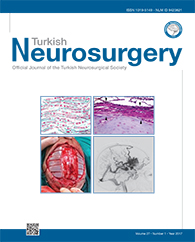2Keio University School of Medicine, Departments of Otorhinolaryngology, Head & Neck Surgery, Shinjuku, Tokyo, Japan DOI : 10.5137/1019-5149.JTN.14354-15.0 AIM: This study aimed to assess the efficacy of endoscopic endonasal surgery, conducted by a team of neurosurgeons and otolaryngologists.
MATERIAL and METHODS: We studied 40 patients who were undergoing surgery for primary non-functional pituitary adenomas with Knosp grades 1 to 3, at Keio University Hospital between 2005 and 2012. We compared the endoscopic endonasal transsphenoidal approach (team-eTSS; T-eTSS), with a microscopic transsphenoidal approach (mTSS). Analyses were conducted for differences between the two groups in tumor resection rates, operating durations, and complications from the non-functional pituitary adenomas. We also compared the heminostril and binostril approaches for T-eTSS.
RESULTS: Tumor resection rates were higher when the surgeries were conducted by T-eTSS than mTSS. In particular, when the maximum tumor diameter was more than 25 mm, resection rates were significantly higher for T-eTSS than for mTSS. There were no unexpected complications in either group. There was no significant difference in resection rates between the heminostril and binostril approaches when T-eTSS was performed.
CONCLUSION: T-eTSS is an efficacious surgical option for non-functional pituitary adenomas, particularly when the adenoma is of large size. Benefits of the heminostril approach are evident.
Keywords : Endoscopic endonasal surgery, Pituitary adenoma, Heminostril approach, Transsphenoidal




